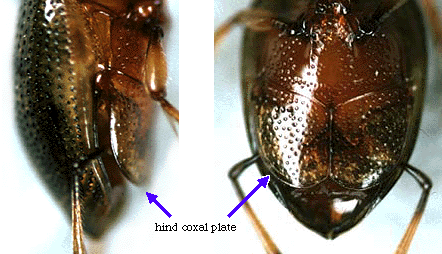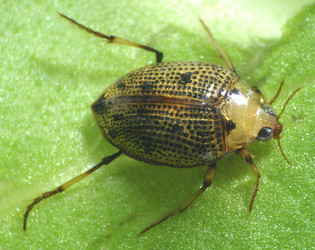Haliplidae
Crawling water beetles
Rolf Georg Beutel and Bernhard van Vondel


This tree diagram shows the relationships between several groups of organisms.
The root of the current tree connects the organisms featured in this tree to their containing group and the rest of the Tree of Life. The basal branching point in the tree represents the ancestor of the other groups in the tree. This ancestor diversified over time into several descendent subgroups, which are represented as internal nodes and terminal taxa to the right.

You can click on the root to travel down the Tree of Life all the way to the root of all Life, and you can click on the names of descendent subgroups to travel up the Tree of Life all the way to individual species.
For more information on ToL tree formatting, please see Interpreting the Tree or Classification. To learn more about phylogenetic trees, please visit our Phylogenetic Biology pages.
close boxIntroduction
The Haliplidae or crawling water beetles are a comparatively small group of inconspicuous, small water dwelling insects. They belong to the coleopteran suborder Adephaga, but differ from all other families of this taxon in several important characters. The strictly algophagous habit of haliplid larvae is a feature not found in any other taxon of the almost exclusively carnivorous Adephaga. The extremely enlarged hind coxal plates of adults are also a highly unusual feature of Haliplidae. They function as an accessory breathing air storage and physical lung.
The family contains 5 genera in current classifications (Lawrence & Newton 1995) and 204 species world wide (v. Vondel 2005b). Recently 36 new species were described from the Oriental, Neotropical, Australian and Afrotropical regions, while 3 species were synonymised and 1 synonym was reinstalled as a separate species (v. Vondel 2007, v. Vondel & Spangler 2008a; v. Vondel 2008b; v. Vondel 2009; Watts & McRae 2010; v. Vondel 2010), bringing the total on 238 species. Adults live among aquatic vegetation along the edges of ponds, lakes, creeks or streams. They prefer a mixed diet of chironomid eggs, oligochaet worms, small crustaceans, hydrozoans, algae, characeans and probably seed-plants (Seeger 1971a; v. Vondel 1997). The relative amount of algae is usually less than 50%. The swimming abilities are rather poor. Middle and hind tibiae are not flattened but equipped with a fringe of swimming hairs. The legs move alternately in contrast to predacious diving water beetles or most whirligig beetles. The English name of the group refers to their habit of crawling along different water plants. Larvae are mostly found among masses of algae or characeans. They move slowly and are very easily overlooked in their preferred habitat. Haliplid larvae suck the contents of single cells of algae or characeans with their highly specialized mandibles. They breathe by means of dorsal tracheal gills or microtracheal gills.
Characteristics
Adults: The body is 1.5-5.0 mm in length, strongly convex dorsally, and boat-shaped. Most species are testaceous with more or less distinct rows of black punctures on the elytra. The head is prognathous and slightly broader than long (see Dressler & Beutel [2010] for a detailed description of head structures). The eyes are distinctly protruding. The 11-segmented antennae are devoid of pubescence and filiform. The basal antennomere (scapus) is unusually short. The prosternal process is broadened, truncate apically and adjacent with the metaventral process posteriorly. The metaventral transverse ridge is complete. The metacoxae are immobilized but not fused medially (Belkaceme 1986). The metacoxal plates conceal the basal abdominal segments and the trochanters and femorae of the hind legs.


Enlarged metacoxal plates of Haliplus.
All legs are slender and not flattened. A protibial antenna cleaning organ is absent. Swimming hairs are present on the tibiae and tarsi. Wings are hyaline and well developed in most species, but absent in the non-European genera Algophilus and Apteraliplus (generic status, see below). Venation and folding of adephagan type, with cubital hinge not far from oblongum cell. Folding aided by tergal binding patches.
Larvae: The body is elongated, narrow, and strongly sclerotized. The head is small and equipped with highly specialized mandibles with a conspicuous sucking channel (Seeger 1971b; Beutel 1986). Maxillae and labium are adapted to handle algae during the feeding process. The short legs have a single claw. Different climbing devices are present on the fore legs (Jaboulet 1960; Vondel 1997). Abdomen with eight (Peltodytes) or nine (Brychius, Haliplus) distinct segments and additional (terminal) segment. Non-articulated and non-segmented urogomphi present, not or scarsely fused at base (Peltodytes), partly fused (Brychius, Haliplus in part) or completely fused (Haliplus in part.) Long filamentous gills or short microtracheal gills are present on the thoracic terga and on the abdominal terga except terminal segment (Jaboulet 1960; Seeger 1971b, Vondel 2005). Functional spiracles are present in third instar larvae on the mesothorax and the abdominal segments I-VII.
Genera of Haliplidae
Five genera are currently formally recognized (e.g., v. Vondel 2005a, b). The monotypic genera Apteraliplus Chandler (Northern California) and Algophilus Zimmermann (Southern Africa) were erected on the basis of conspicuous autapomorphous features (e.g. absence of wings: Apteraliplus). They are probably closely related with a subgroup of the largest genus Haliplus Latreille (Beutel & Ruhnau 1990; J. Bergsten, pers. comm.). Therefore, the generic status is not appropriate, leaving three genera:
- Peltodytes
- Brychius
- Haliplus
Relationship of Haliplidae to Other Adephaga
The systematic position of Haliplidae is not settled yet. They were placed as the second offshoot of Adephaga in Beutel et al. (2006) and earlier morphology based studies. The monophyly of Adephaga excl. Gyrinidae and Haliplidae (=Trachypachidae, Dytiscoidea, Caraboidea) is suggested by several apomorphic features of larvae: cephalic egg bursters are present (Arndt 1993), the maxillary groove is completely reduced, and M. tentoriolacinialis is attached to the mesal stipital base (Beutel 1993). A sistergroup relationship between Haliplidae and Dytiscoidea (including Meruidae and Aspidytidae) was discussed in Dressler & Beutel (2010), a study also based on morphological data. The family was variously placed in a recent molecular study by Maddison et al. (2009), with Haliplus and Peltodytes not forming a clade in some of the analyses.
Discussion of Phylogenetic Relationships
The monophyly of Haliplidae is supported by several striking autapomorphies (e.g. large metacoxal plates, highly specialized mouthparts and algae feeding habits of larvae).
Peltodytes is probably the sistergroup of the remaining genera. They are characterized by lateral tubercles of the head and microtracheal gills as larvae (Seeger 1971b; Beutel 1995). A subulate labial palpomere II, partly reduced elytral sutural striae, asymmetric parameres, and specialized egg-laying habits are apomorphies of adults (Beutel 1995; Beier 1929; Galewski 1972).
Brychius is the sistergroup of Haliplus (including Algophilus and Apteraliplus). Sensory tubercles are present on the laciniae of larvae of Haliplus (Jaboulet 1960; Beutel 1995). Complete absence of the sutural striae, sternal bulges on abdominal sternites V-VII, and the rudimentary setal fringe on the left paramere are apomorphic features of adults (Beutel & Ruhnau 1990).
A monophylum comprising Algophilus, Apteraliplus, and the Haliplus-subgenus Liaphlus is supported by the presence of two posterolateral ridges on the head, the presence of a digitiform appendage on the left paramere, and strong, caudolaterally dilated apodems of the gonocoxae (Beutel & Ruhnau 1990).
References
Arndt, E. 1993. Phylogenetische Untersuchungen larvalmorphologischer Merkmale der Carabidae (Insecta: Coleoptera). Stuttgarter Beiträge zur Naturkunde (A), 488: 1-56.
Beier, M. (1929): Zur Kenntnis der Lebensweise von Haliplus wehnckei Gerh. Zeitschrift für Morphologie und Ökologie der Tiere, 14: 191-233.
Belkaceme, T. 1986. Skelet und Muskulatur der Hinterhüfte von Haliplus lineatocollis Mrsh. (Haliplidae, Coleoptera). Stuttgarter Beiträge für Naturkunde (A), 393: 1-12.
Beutel, R. G. 1993. Phylogenetic analysis of Adephaga (Coleoptera) based on characters of the larval head. Systematic Entomology, 18: 127-147.
---- 1995. The Adephaga (Coleoptera): phylogeny and evolutionary history. Pp. 173-217 in J. Pakaluk and S. A. Slipinski (eds.), Biology, Phylogeny, and Classification of Coleoptera: Papers Celebrating the 80th Birthday of Roy A. Crowson. Muzeum i Instytut PAN, Warszawa.
Beutel, R. G. & S. Ruhnau 1990. Phylogenetic analysis of the genera of Haliplidae (Coleoptera) based on characters of adults. Aquatic Insects 12 (1): 1-17.
Beutel, R.G., M. Balke & W.E. Steiner. 2006. On the systematic position of Meruidae (Coleoptera, Adephaga) and the phylogeny of the smaller hydradephagan families. Cladistics. 22: 102-131.
Dressler, C. & R.G. Beutel. 2010. The morphology and evolution of the adult head of Adephaga (Insecta, Coleoptera). Arthropod Systematics and Phylogeny 68: 239-287.
Galewski, K. 1972). Significance of the mandible shape for the identification of females of the European species of Haliplidae (Coleoptera). Bulletin de l' Academie Polonaise des Sciences, Séries des Sciences Biologiques, 20 (12): 867-871. Warschau.
Jaboulet, M.C. 1960. Contribution a l'étude des larves d' Haliplides. Travaux du Laboratoire de Zoologie et de la Station Aquicole Grimaldi de la Faculté des Sciences de Dijon 31: 1-17.
Blackwell Publishing Ltd
Maddison, D.R., W. Moore, M.D. Baker, T.M. Ellis, K.A. Ober, J.J. Cannone, R.R. Gutell 2009. Monophyly of terrestrial adephagan beetles as indicated by three nuclear genes (Coleoptera: Carabidae and Trachypachidae). Zoologica Scripta 38: 43-62.
Seeger, W. 1971a. Autökologische Untersuchungen an Halipliden mit zoogeographischen Anmerkungen. Archiv für Hydrobiologie 68 (4): 528-574.
Seeger, W. 1971b. Morphologie, Bionomie und Ethologie von Halipliden, unter besonderer Berücksichtigung funktionsmorphologischer Gesichtspunkte (Haliplidae; Coleoptera). Archiv für Hydrobiologie 68 (3): 400-435.
Vondel, B.J. v. 1997. Haliplidae. Pp. 1-95 in Schwoerbel, J & Zwick, P (eds.) Süsswasserfauna von Mitteleuropa 20.2. Gustav Fischer, Stuttgart.
Vondel, B.J. v. 2005a. 7.2. Haliplidae Aubé, 1936. Pp. 64-72 in R.G. Beutel and R.A.B. Leschen (eds.), Handbook of Zoology, Vol. IV Arthropoda: Insecta. Part 38. Coleoptera, Vol. 1: Morphology and Systematics (Archostemata, Adephaga, Myxophaga, Polyphaga (partim). Walter De Gruyter, Berlin, New York.
Vondel, B.J. v. 2005b. Haliplidae. In A.N. Nilsson (ed.), World Catalogue of Insects (Vol. 7. Amphizoidae, Aspidytidae, Haliplidae, Noteridae and Paelobiidae (Coleoptera, Adephaga). Apollo Books, Stenstrup, 171 pp.
Vondel, B.J. v. 2007. World Catalogue of Haliplidae – corrections and additions, 1 (Coleoptera: Haliplidae). Koleopterologische Rundschau 77: 89-96.
Vondel, B.J. v. 2008. A new species of Haliplidae from Sulawesi (Coleoptera: Haliplidae). Tijdschrift voor Entomologie 151:141-143, Figs 1-9.
Vondel, B.J. v. 2009. Review of the Haliplidae of Myanmar with description of Haliplus volpei (Coleoptera). Tijdschrift voor Entomologie 152:333-338.
Vondel, B.J. v. 2010. Revision of the Haliplidae of the Afrotropical region, including North Africa (Coleoptera). Tijdschrift voor Entomologie 153: 239-314.
Vondel, B.J. v. & P.J. Spangler 2008. Revision of the Haliplidae of the Neotropical region including Mexico (Coleoptera: Haliplidae). Koleopterologische Rundschau 78: 69-194.
Watts, C.H.S. & McRae, J. 2010. The identity of Haliplus (Coleoptera: Haliplidae) from the Pilbara region of Australia, including the description of four new species. Records of the Western Australian Museum 25: 387-398.
Title Illustrations

| Scientific Name | Peltodytes dispersus |
|---|---|
| Location | USA: Arizona: Arivaca Creek near Arivaca |
| Specimen Condition | Live Specimen |
| Identified By | David Maddison |
| Collection | DRM 02.003 |
| Image Use |
 This media file is licensed under the Creative Commons Attribution License - Version 3.0. This media file is licensed under the Creative Commons Attribution License - Version 3.0.
|
| Copyright |
© 2002 David R. Maddison

|
About This Page
Rolf Georg Beutel

Friedrich-Schiller-Universität Jena, Germany
Correspondence regarding this page should be directed to Rolf Georg Beutel at and Bernhard van Vondel at
Page copyright © 2011
All Rights Reserved.
- First online 14 October 1996
- Content changed 08 February 2011
Citing this page:
Beutel, Rolf Georg and Bernhard van Vondel. 2011. Haliplidae. Crawling water beetles. Version 08 February 2011 (under construction). http://tolweb.org/Haliplidae/8884/2011.02.08 in The Tree of Life Web Project, http://tolweb.org/







 Go to quick links
Go to quick search
Go to navigation for this section of the ToL site
Go to detailed links for the ToL site
Go to quick links
Go to quick search
Go to navigation for this section of the ToL site
Go to detailed links for the ToL site